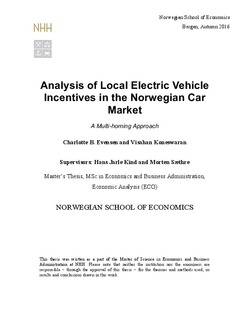Analysis of local electric vehicle incentives in the Norwegian car market : a multi-homing approach
Master thesis
Permanent lenke
http://hdl.handle.net/11250/2432542Utgivelsesdato
2016Metadata
Vis full innførselSamlinger
- Master Thesis [4372]
Sammendrag
This paper analyse how the local incentives for electric vehicles affect the number
of people that purchase both conventional and electric vehicles. After the threshold
of 50 000 electric vehicles was reached in April 2015, there has been an ongoing debate
regarding whether the incentives for electric vehicles should be withheld. The
intent of the incentives is to develop a more climate friendly vehicle fleet. Although
the incentives impact on joint purchase is important to understand how efficient the
incentives are in achieving the policy objective, we are not aware of any research
on this area up to this point. Our contribution is a theoretical model that allow
consumers to purchase multiple differentiated product varieties, a behavior defined
as multi-homing. The model predicts that multi-homing softens the competition
between electric and conventional vehicles and partially absorbs the demand shifting
effect of the incentives. Furthermore, we conduct empirical research on the car
market to analyse how the car market historically has reacted to the incentives. Our
findings coincide with the model's predictions at a satisfactory level. We find that
all incentives increase the number of multi-homers. While our estimations shows
that free ferry admission leads to an increased vehicle fleet, the introduction of toll
stations, congestion charge and road toll lead to a reduction in the overall vehicle
stock. The empirical results reveal that the incentives only seem to phase out sales of
conventional cars if they are derivatives of policy instruments with a negative effect
on the demand for conventional vehicles.
